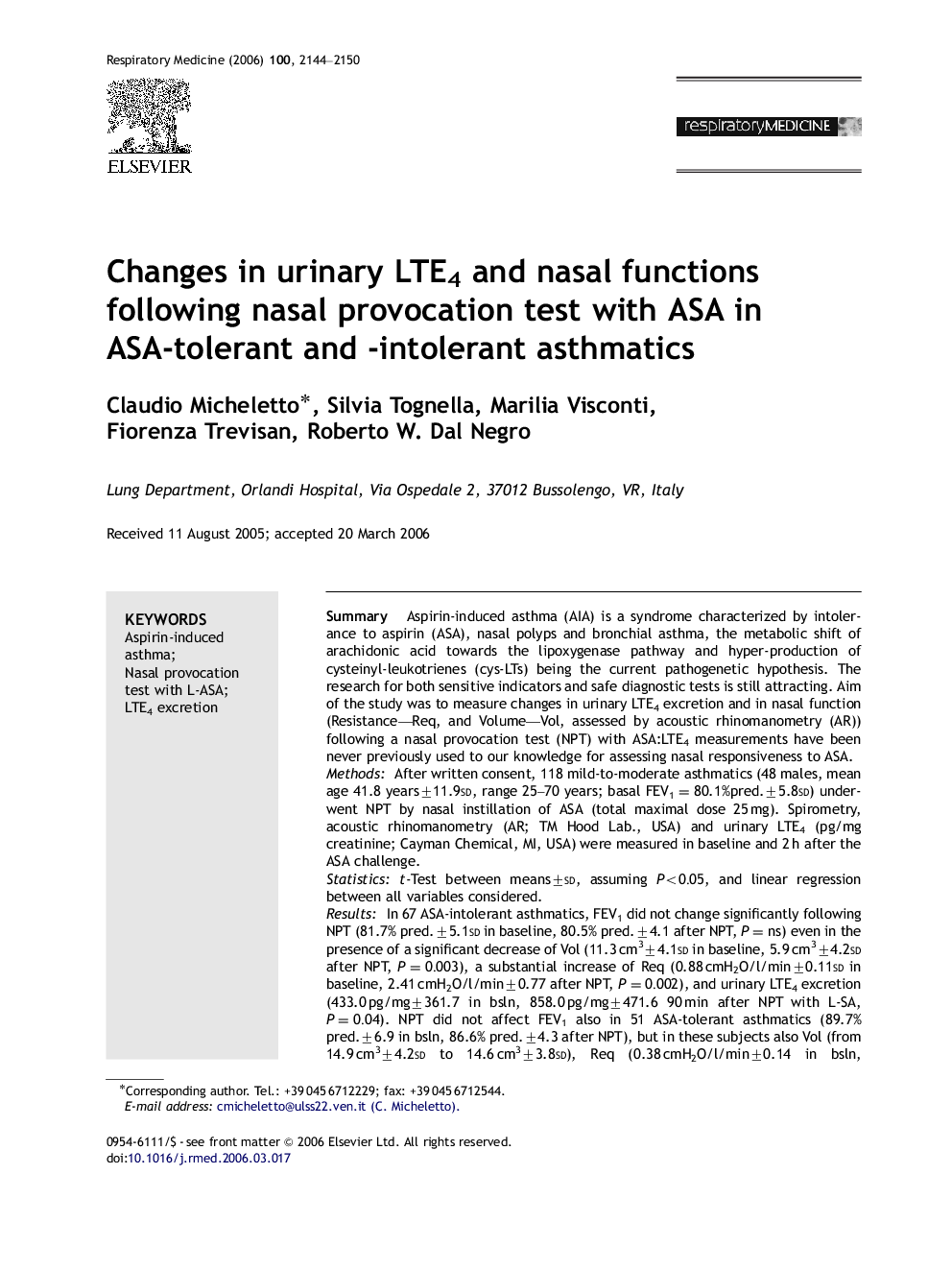| Article ID | Journal | Published Year | Pages | File Type |
|---|---|---|---|---|
| 4211987 | Respiratory Medicine | 2006 | 7 Pages |
SummaryAspirin-induced asthma (AIA) is a syndrome characterized by intolerance to aspirin (ASA), nasal polyps and bronchial asthma, the metabolic shift of arachidonic acid towards the lipoxygenase pathway and hyper-production of cysteinyl-leukotrienes (cys-LTs) being the current pathogenetic hypothesis. The research for both sensitive indicators and safe diagnostic tests is still attracting. Aim of the study was to measure changes in urinary LTE4 excretion and in nasal function (Resistance—Req, and Volume—Vol, assessed by acoustic rhinomanometry (AR)) following a nasal provocation test (NPT) with ASA:LTE4 measurements have been never previously used to our knowledge for assessing nasal responsiveness to ASA.MethodsAfter written consent, 118 mild-to-moderate asthmatics (48 males, mean age 41.8 years±11.9sd, range 25–70 years; basal FEV1=80.1%pred.±5.8sd) underwent NPT by nasal instillation of ASA (total maximal dose 25 mg). Spirometry, acoustic rhinomanometry (AR; TM Hood Lab., USA) and urinary LTE4 (pg/mg creatinine; Cayman Chemical, MI, USA) were measured in baseline and 2 h after the ASA challenge.Statisticst-Test between means±sd, assuming P<0.05P<0.05, and linear regression between all variables considered.ResultsIn 67 ASA-intolerant asthmatics, FEV1 did not change significantly following NPT (81.7% pred.±5.1sd in baseline, 80.5% pred.±4.1 after NPT, P=ns) even in the presence of a significant decrease of Vol (11.3 cm3±4.1sd in baseline, 5.9 cm3±4.2sd after NPT, P=0.003P=0.003), a substantial increase of Req (0.88 cmH2O/l/min±0.11sd in baseline, 2.41 cmH2O/l/min±0.77 after NPT, P=0.002P=0.002), and urinary LTE4 excretion (433.0 pg/mg±361.7 in bsln, 858.0 pg/mg±471.6 90 min after NPT with L-SA, P=0.04P=0.04). NPT did not affect FEV1 also in 51 ASA-tolerant asthmatics (89.7% pred.±6.9 in bsln, 86.6% pred.±4.3 after NPT), but in these subjects also Vol (from 14.9 cm3±4.2sd to 14.6 cm3±3.8sd), Req (0.38 cmH2O/l/min±0.14 in bsln, 0.26 cmH2O/l/min±0.2 after NPT, P=ns), and urinary LTE4 (333.1 pg/mg±202.8 in bsln, 318.0 pg/mg±198.7 after NPT, P=ns) remained unchanged. Only pre-NPT LTE4 values proved related to pre-NPT Req and Vol values (r=0.54r=0.54 and r=-0.71r=-0.71, respectively), but not to patients’ age (R=-0.05R=-0.05), and basal FEV1 (r=0.01r=0.01).ConclusionsIn ASA-intolerant patients, NPT with lysine-aspirin (L-ASA) only induces a substantial nasal obstruction and enhances urinary LTE4 excretion in the absence of any significant bronchial obstruction. Nasal ASA challenge proves a test absolutely safe for asthma patients suspected of ASA intolerance. Measures of urinary LTE4 excretion contributed significantly to magnify the discriminant and the diagnostic value of NPT.
